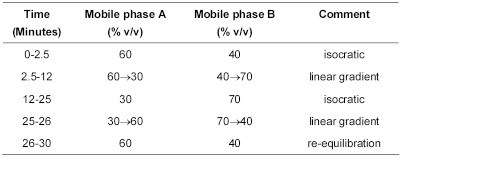Meloxicam Tablets
Action and use
Cyclo-oxygenase inhibitor; analgesic; anti-inflammatory.
Definition
Meloxicam Tablets contain Meloxicam.
Content of meloxicam, C14H13N3O4S2
95.0 to 105.0% of the stated amount.
Identification
1 volume of 13.5m ammonia, 20 volumes of methanol and 80 volumes of dichloromethane.
The principal spot in the chromatogram obtained with solution (1) corresponds to that in the chromatogram obtained with solution (2).
Tests
Dissolution
Comply with the requirements for Monographs of the British Pharmacopoeia in the dissolution test for tablets and capsules, Appendix XII B1.
Calculate the total content of Meloxicam, C14H13N3O4S2, in the medium from the absorbances obtained using the declared content of C14H13N3O4S2 in meloxicam BPCRS.
Related substances
Carry out the method for liquid chromatography, Appendix III D, using the following solutions.
Mobile phase A0.1% w/v of potassium dihydrogen orthophosphate adjusted to pH 6.0 with 2m sodium hydroxide.
Mobile phase Bmethanol.
The test is not valid unless, in the chromatogram obtained with solution (3):
the chromatogram closely resembles the chromatogram supplied with meloxicam impurity standard BPCRS at 260 nm and 350 nm;
the resolution between the peaks due to meloxicam and impurity A at 350 nm is at least 3.0;
the resolution between the peaks due to impurity B and meloxicam at 260 nm is at least 3.0.
In the chromatogram obtained with solution (1):
identify any peak corresponding to impurity A at 350 nm and multiply the area of this peak by a correction factor of 2.0;
the area of any peak corresponding to impurity A at 350 nm is not greater than twice the area of the principal peak in the chromatogram obtained with solution (2) (0.2%);
the area of any peak corresponding to impurity B at 260 nm is not greater than 1.5 times the area of the principal peak in the chromatogram obtained with solution (2) (0.15%).
In both the chromatograms obtained with solution (1) at 350 nm and at 260 nm:
the area of any other secondary peak is not greater than twice the area of the principal peak in the chromatogram obtained with solution (2) at that wavelength (0.2%).
The nominal total content of all such impurities is not greater than 0.5%.
Disregard any peak with an area less than the area of the principal peak in the chromatogram obtained with solution (2) at the same wavelength (0.1%).
Assay
Weigh and powder 20 tablets. Carry out the method for liquid chromatography, Appendix III D, using the following solutions.
The chromatographic conditions described under Related substances may be used with a detection wavelength of 350 nm.
The Assay is not valid unless, in the chromatogram obtained with solution (3):
the chromatogram closely resembles the chromatogram supplied with meloxicam impurity standard BPCRS;
the resolution between the peaks due to meloxicam and impurity A is at least 3.0.
Calculate the content of C14H13N3O4S2 in the tablets using the declared content of C14H13N3O4S2 in meloxicam BPCRS.
Impurities
The impurities limited by the requirements of this monograph include those listed under Meloxicam.
